This fall Canyon Day was held on October 5th. A beautiful fall day surrounded the activities which included the removal of 6-cubic yards of invasive plant material, and the reintroduction of over 800 native understory shrubs and ground covers.
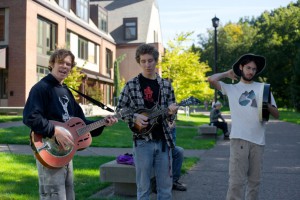
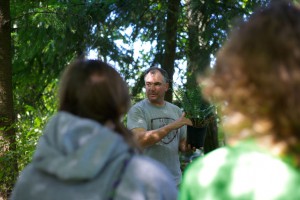
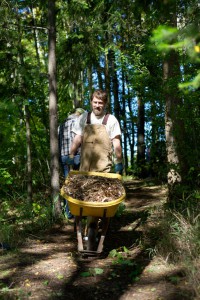
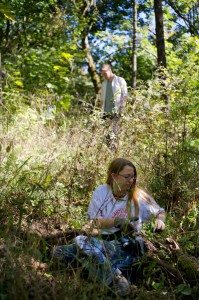
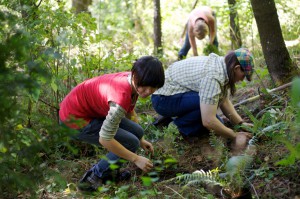
This fall Canyon Day was held on October 5th. A beautiful fall day surrounded the activities which included the removal of 6-cubic yards of invasive plant material, and the reintroduction of over 800 native understory shrubs and ground covers.





The canyon fell into the trusting hands of the ‘crew’ this past summer. Their dedication to protecting this headwater forest and the cleanest water source in the City of Portland will leave a lasting impression on this campus.
Don’t let their smiles fool you- Canyon Crew is an assembly of trained killers (seen here performing their victory dance of destruction).
These students gave their blood, sweat and tears (of joy) to the canyon this summer and for that the canyon is forever grateful. The restoration and protection of this natural beauty is something that takes the support of its community to rebuild. Every season (almost every day) we observe changes in our canyon that echo and reflect the college’s commitment to preserving and improving the natural springs that bubble up from the depths- and provide the headwaters to the last free-flowing creek within the city, to the Pacific Ocean.
This summer we spotted our first deer in the canyon, and a thriving population of Osprey competing with river otter for fish within Reed Lake. Seeing these larger species come in and follow on the heels of the rehabilitation of these 28 acres of forest continue to remind us how special and unique Reed Canyon is tucked into this beautiful campus, surrounded by this beautiful city.
This summer Canyon Crew gave focus to improving the safety of our 1.8 miles of trail that serpentines though these woods- all the while ripping and tearing invasives from the comfort of their beautiful settings.
Reed College has decided to forgo the use of pesticides to accomplish our goals of restoration within Reed Canyon which may prove to be more labor intensive- but it’s obvious that this mechanical approach has helped preserve non-target species both plant and amphibian- that we continue to add to our species list for further study.
The Canyon Crew is a special group- They make lasting impressions on the livability of our most special wildlife habitat. Their efforts and are appreciated by all who wander our woods.
Took a walk at lunchtime around the canyon, and there’s plenty of ample signs of beaver work. Decided to take a closeup of what their dentures have been doing to one particular tree . . .
Just a few colors blooming out there this summer!
[nggallery id=1]
Well, the ground is hardened and the trails are little dusty out there- in the distance, you can see wide-eyed freshman descending on the campus.
It must be the beginning of school here at Reed again. The 2012 summer canyon crew has officially left their mark on the soils deep within. New benches were created in the eastern portion of the canyon-giving visitors close look at the first set of springs emerging from the aquifers below.
This summer we can look back and raise our water bottles to the great loss of invasive vegetation- without them we wouldn’t be here today- and in their absence we toast our achievements. For your safety, sections of trails have been repaired and widened and now await your next visit- providing safe access and sure footing no matter what time of day.
In addition to the daily rigors of weeding the canyon- we successfully finished stabilizing the section of the creek under the theater building. Frequent streamside and water access though out the years had pushed that section of the canyon into a degraded state- and the ever widening portion of creek edge not only impacted the spawning grounds downstream, but led to a widening of the creek- resulting in a shallow riffle with no stream bottom complexity.
This summer the canyon has been rewarded with its patience at the hands of the Canyon Crew. Their persistence for protection has freed the indigenous natives from the smothering effects of Wild Clematis (Clematis vitalba) and the ever-sneaky morning glory (Calystegia sepium). Next time you walk the trails you will see the results of their hard work and see first-hand why so eagerly they give their blood, sweat, and tears (of joy) to the Reed Canyon. Even in these past few months we have seen and documented an increase in native wildlife attracted to the canyon’s developing food and habitat communities. To be a witness of the intertwine- and see the results of your work almost immediately- is sometimes all the thanks one needs. We could see birds in the distance flocking to the newly uncovered patches of snow and thimble berries just uncovered. A quick rest for some and a meal accompanied by the sounds of Crystal Springs Creek flowing in the background.
Thank you Canyon Crew for all your hard work- your work may not always be easy to see- but as we continue to succeed year after year at these little tasks laid before you, we can see the big picture. This summer the canyon continued it’s transformation towards becoming an elite self-sustaining ecosystem at the center of an elite institution.
It's Summer Time! And in our continued attempt to restore and protect this beautiful resource, Canyon Crew has been diligently removing invasive plant materials, and expanding their "toolbox" of tricks to insure safe travels in and around the canyon trail system. In addition to mastering the terrestrial aspects of the canyon restoration, Canyon Crew has been working to stabilize and solidify the area under the theater building. Years of misuse and neglect have caused large areas under the theater to erode into the creek, silting the gravels that are needed for successful fish spawning.
We are fortunate to be caretakers of such a beautiful natural resource- and insuring clean water and safe passage for fish is part of our goal-set. If you remember our creek leaves Reed Lake as a 5-foot wide, swift moving clean body of water-, which then meanders though a densely vegetated wetland forest. As it approaches the theater building the meandering becomes less so, and the creek nears an almost straitened-flow essentially ‘blowing-out’ under the theater to a width of 16feet wide. This widening effect then makes for a more shallow section of stream- essentially creating a barrier for our migratory wildlife. Historically our springs flow between 4 and 7 cubic feet per second (cfs), which is great if the stream channel is deep, narrow and has enough off channel pools and protection with overhanging vegetation. But when spread over a large area the dept is lost and travel becomes limited. I have noticed in the recent past that larger fish coming to Reed Canyon to spawn would literally get stuck on the small gravels under the building not allowing access to their desired spawning area, essentially forcing fish to retreat and look for less-ideal gravels downstream. With minimal channel deepening we could create a passable section under the building and call that good, but within this particular area of degradation a widened stream results in a slower flow, and this slowing effect encourages suspended solids to deposit into the pools we created resulting in a stream-bed that would then over time return to a impassible gravel bar-
So in order to sustain the work and time that we put into this project we have come up with an idea that changes the velocity of the creek all the while providing structure and habitat for aquatic critters.
In short, we have seen that as we create deepened pools for rest along the stream corridor, the introduction of large-woody debris (logs, root wads) on the up-stream side of the pool pinches the creek and speeds up the water, which then scours the pools- keeping them free of organic debris. Over time this change in flow maintains our needs to have a more irregular stream bed- and is regarded as a more idealistic spawning habitat.
With this project in mind, this last spring we were able to coordinate with the construction team working on the new Performance Art Building at the western edge of campus- and use their crane and personal to lower 15-tons of boulders down the steep slope off Botsford Drive to the edge of the theater building.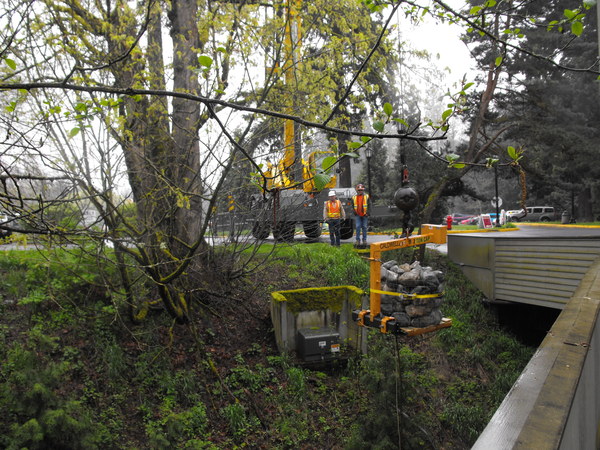
So now we have to move all that rock?
So with some ingenuity and imagination Canyon Crew was able to construct a ‘rock mover’ (for lack of a better name) out of two tire chains and two non-native maple trees- making moving large rock easy for two able bodied Reedies. The work will be ongoing and the results will be based on this projects ability to withstand canyon-goers and their natural instinct to move and disrupt the efforts prior to their visits. Under the theater you’ll see the benefits of the large wood being placed in these pools being complimented by the placement of boulders and river rock along the stream edge, which acts to protect the new meander and limits the impact of visitors to that sensitive area.
So next time you visit Reed Canyon take a closer look at the flow of the creek- notice the large logs that have been introduced- you now have the insight that there is a deep pool there and if you can get close enough, a great vantage point to see fish at rest.
Submitted by: Haleigh Ziebol, Class of 2015
Although I am a new member of Canyon Crew this Summer, I am not, by any means, a newcomer to Reed’s canyon. As I gazed over the Blue Bridge when I arrived as a young freshman back in August, the Canyon’s pristine waters amazed me. The burgeoning trees. The birds. The overarching sky. The purity. This place was familiar and beautiful.
A smile stretched across my face, while fond memories of the Minnesota River Valley’s trails filled my mind. Soon enough my feet were striding down steps that I would frequently tread in the months to come.
And tread I did. After most morning Humanities lectures I spent thirty minutes slowly padding along- breathing and being, soaking up the atmosphere through each of my senses. I loved to observe all the plants, and to note the differences between days, weeks and months as they carried out their life cycles. I enjoyed the change of pace from the classroom and from my daily life.
With each step, I experienced a tangled mess of pent-up thoughts and feelings. I weathered this inner-turmoil just like the Canyon maintains itself through seasonal changes and inclement weather. Everything simply passed through me, and by the end of these walks, I took my leave a human being rekindled.
Harboring an almost spiritual connection and a full-fledged aesthetic appreciation for the Canyon, I was excited to be accepted to the ranks of Canyon Crew. On Thursday, May 31st at 8:30 A.M. I arrived prepared to preserve and further discover and develop a special place.
Over my first week on the job I’ve discovered that Canyon Crew’s efforts center on the idea of balance. Outside forces, like the human visitors constantly interact with the Canyon. Due to the fact that the human interaction cannot be prevented -and is desired– the Crew oversees these interactions with the intent of preserving, to the best of our ability, the Canyon's natural state. It becomes a game of balance, mediating between both sides so that the Canyon (first and foremost) and its visitors are satisfied.
We negotiate the balance amongst invasive species and the Canyon’s natural inhabitants. The Crew devoted many hours to removing blackberry bushes, Morning Glory vines, thistles, Garlic Mustard and Clematis, all of which pose threats to the desired diversity of natural plants. Though the Crew will never remove every invasive plant, we certainly work to remove all that we can- ever attempting to preserve the balance. We also oversee the struggle between the human and natural sphere by keeping the Canyon free of garbage and accessible to its visitors. Last week this meant trekking along all the trails, machetes and scythes in hand, trimming back plants that were overrunning the paths. The chainsaw even made a guest appearance to prune some overhanging branches.
In the aforementioned precarious balance between man and nature, the beavers constantly tip the scale with their dam building. At dusk the beavers swim upstream with logs, grasses and rocks in tow to a place near the springs. Here, a few feet from the boardwalk, they construct dam after dam, not to be discouraged by the countless times that the Crew has removed them. (If you head down to the Eastern Canyon at nightfall, you just might be able to watch them.) The dams impede water flow, interfering with the salmon run and threatening to flood the boardwalk. For these reasons the Crew dutifully steps into long boots, slushes through the water and removes the masses of sticks and grasses, committed to preserving the Canyon’s balance.
In typical fashion spring in Oregon is well- predictably, unpredictable. We broke records for the longest stretch of dry weather for the month of May- only followed by wet windy weather which may send non-native residents running for their umbrellas. But all together the month has averaged out to be a 'typical' beautiful spring here in the Northwest. The canyon is a beautiful place to witness the changes in seasons, right now the lake is swarming with baby ducks, and geese-
Geese are an interesting beast- growing up in the Northwest I was never in awe of the presence of geese- they seemed to be everywhere, all the time. And in the canyon they seem to frolic and honk to no end- intriguing and entertaining for kids of all ages- but not a feature alone that makes the canyon different from your city park…
But this is where this story evolves into something special-
Alone geese are geese- doing geese things, but in an ecosystem like the Reed canyon- we start to see how relationships between different creatures start to intertwine, and you could observe the benefits of letting nature take its natural course. Next time you visit Reed canyon and you find yourself on the island below the Chemistry building- take a look to the NE- I've been watching our resident beavers construct a very impressive dam, trapping the spring water from the east, consequently raising the water level up over a foot in some of the areas closest to the dam. The water level itself seems to go up and down weekly depending on the activity of the beavers and their ability to constantly plug the holes in their dam. Some may argue that the damming of the springs will cause negative effects on the system by trapping the cold, clean spring water allowing it to warm up during the later days of summer.. And others can argue that the ability to create back water in what was once a marsh- creates opportunities for increased biodiversity- and further water cleansing. Beaver dams have also been shown to be beneficial to frog populations, likely because they provide protected areas for embryos and tadpoles, to mature in warmer, well-oxygenated water. (Which has been highlighted as a concern in recent thesis studies of the canyon.) In early spring the water is too cold and is viewed as a problem for acceptable frog development).
A second benefit that I've been observing during this time period is that the area that is now flooded- is an area that we have found most difficult to rehabilitate-A well established pocket of Reed Canary Grass (Phalaris arundinacea)- 'no relation to the college'
Since we have chosen to not use herbicides in our restoration efforts the persistent nature of this bunch-grass has made it difficult to establish native flowering shrubs and forbs. We've been cutting it, pulling it and trying to out compete it with larger willow, and dogwood cuttings. In other areas downstream that lack constant management- this grass can create a rhizome layer choking water and animal passage, with a grass blades 8 feet tall.
So back to the goose story- with the dam now structurally sound- the area infected with this grass has now been flooded- in some cases drowning the grass-crown. This back water is now inviting to a diverse group of water fowl that prior couldn't walk though this area- allowing them to swim through and feed on the new nutrient-rich meristems, essentially grazing the grass continuously and limiting this plants ability to grow and spread…and seed.
As we see here these young geese are welcomed stewards of the canyon- being taught by their proud parents to protect their home and assist in the ongoing restoration efforts.
Using native wildlife as a 'tool' for restoration? This will be a very interesting study to watch unfold before our eyes…
Join the conversation on 'Reed Canyon' Facebook page- share your stories and pictures with others in the community whom share your feelings about Reed College Canyon.
With the restoration of Reed Canyon, we’ve been accumulating a lot of native critters. Here’s a selection of some recent sightings:
Otters are making increasingly regular appearances in the Canyon – look for them early morning, particularly by the outdoor amphitheatre
A video of the same otter frolicking away can be seen here:
Baby ducks are also making an appearance:
A hummingbird preparing to perch:
Canadian Geese make a particular fuss in the early morning. Most will simply pass through the Canyon on the way to other climes, though some will stay here and nest:
A Western Painted Turtle lounging on a log. Don’t confuse it with its invasive doppleganger, the red-eared slider.
There are many beautiful songbirds in the Canyon peeping out from unexpected niches, such as this wren on a recently fallen cedar.
Interested in other denizens of the Canyon? Check out these previous entries on minks, newts and beavers, or write one up yourself! Questions, comments, concerns? Check out our Facebook page or email Zac Perry at perryz AT reed DOT edu.
So, another Canyon Day has come and gone – but not without leaving a pretty big impact on the Canyon. Here’s a recap of what we did:
This spring, we decided to focus our efforts in the area just south of the Grove (“New”) Dorms, in a bit of property sandwiched between the path to the RCAs, the Farm, and the stream. While small in area, there were many invasives, particularly the tedious-to-remove English Ivy, and few native plants to take their place. Additionally, the trails had fallen into disrepair with the winter rains turning them into mud troughs. Due to the cold and rainy weather, many of us opted for some steaming hot coffee and bagels to start our day off while Zac explained some basics:
Our first major task of the day was to repair the trails enough that they would be able to take the high traffic that would come with Canyon Day. First, we had to clear out the mud in the stairs to revert the path to its original grade.
Then, we had to bring in heaps of gravel (for the sloshiest of areas) and barkchips (for the rest of the paths) to resurface the trails:
Once this task was accomplished, we could turn our focus to the biggest task of the day – removing the English Ivy. Going at it as a front seemed to be the favored strategy:
After we pulled the Ivy, we also had to truck it out lest it reroot in the Canyon. Wheelbarrows returning from dropping off loads of barkchips were used to remove them:
Some people just worked by hand, though:
…or by stick:
After we had enough English Ivy removed from any given location, we could then begin moving in native plants to replace them:
During all this, we had a constant supply of food, provided by a number of student organizations – the Ladies Pie Society, Cookies For All, CAVE (Carniverous Alternatives to Vegetarian Eating), and more. Greenboard also created a selection of excellent Canyon Day tshirts for volunteers:
The Dapper Cadavers provided some wonderful background music for workers as well:
At Canyon Day, we had a huge variety of people come and volunteer, including but not limited to staff, seniors, students and the very very small:
Not everyone was working all the time, though – sometimes people just needed a break:
…and sometimes, we just needed a newt:
So – what did all this accomplish? Here’s some before and after pictures. The full repercussions of having removed the English Ivy won’t be felt for another few years after the natives we have planted have grown in, but it already looks a lot better. Thank you everyone for volunteering your time!
Questions, comments, concerns? Either leave a comment here or on our Facebook page, or email Zac at zperry AT reed DOT edu.